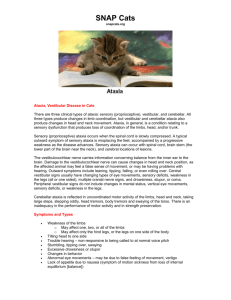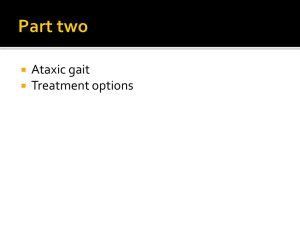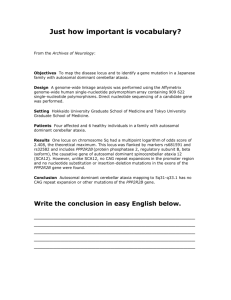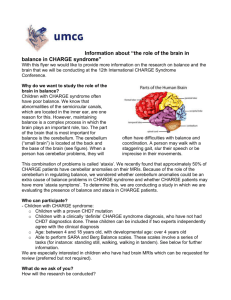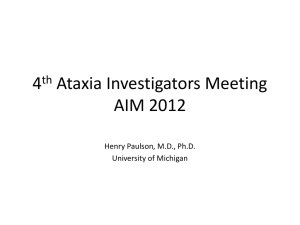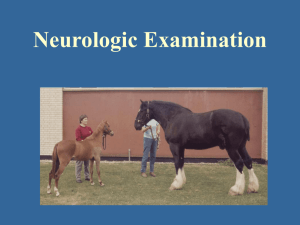Doberman Headbobbing Syndrome
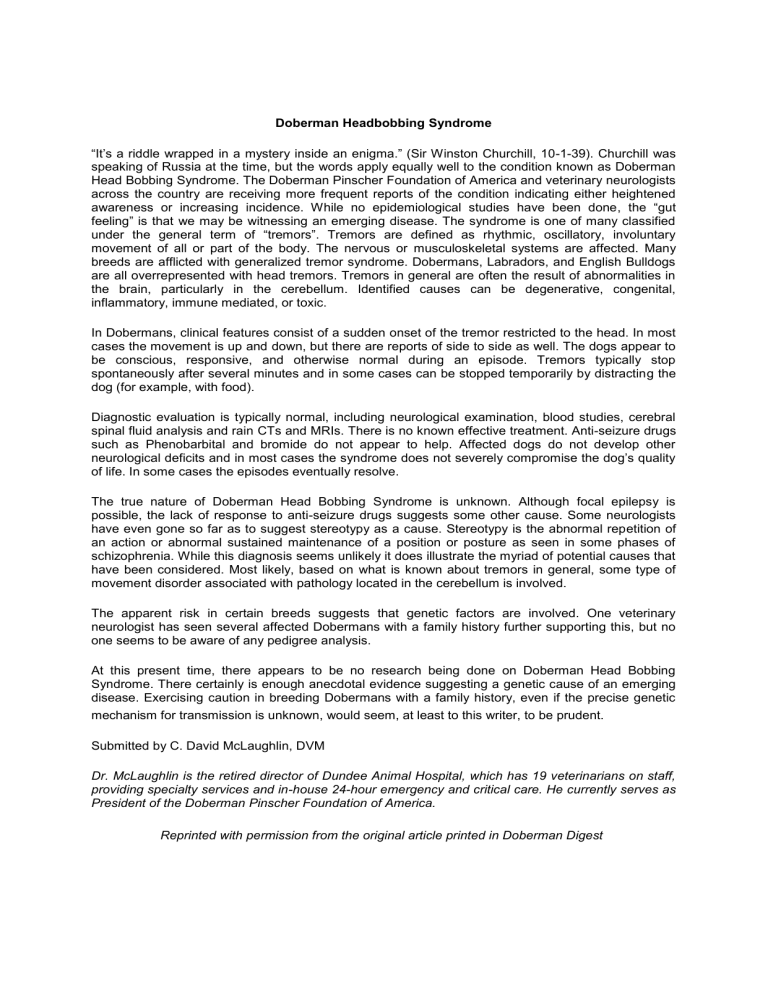
Doberman Headbobbing Syndrome
“It’s a riddle wrapped in a mystery inside an enigma.” (Sir Winston Churchill, 10-1-39). Churchill was speaking of Russia at the time, but the words apply equally well to the condition known as Doberman
Head Bobbing Syndrome. The Doberman Pinscher Foundation of America and veterinary neurologists across the country are receiving more frequent reports of the condition indicating either heightened awareness or increasing incidence. While no epidemiological studies have been done , the “gut feeling” is that we may be witnessing an emerging disease. The syndrome is one of many classified under the general term of “tremors”. Tremors are defined as rhythmic, oscillatory, involuntary movement of all or part of the body. The nervous or musculoskeletal systems are affected. Many breeds are afflicted with generalized tremor syndrome. Dobermans, Labradors, and English Bulldogs are all overrepresented with head tremors. Tremors in general are often the result of abnormalities in the brain, particularly in the cerebellum. Identified causes can be degenerative, congenital, inflammatory, immune mediated, or toxic.
In Dobermans, clinical features consist of a sudden onset of the tremor restricted to the head. In most cases the movement is up and down, but there are reports of side to side as well. The dogs appear to be conscious, responsive, and otherwise normal during an episode. Tremors typically stop spontaneously after several minutes and in some cases can be stopped temporarily by distracting the dog (for example, with food).
Diagnostic evaluation is typically normal, including neurological examination, blood studies, cerebral spinal fluid analysis and rain CTs and MRIs. There is no known effective treatment. Anti-seizure drugs such as Phenobarbital and bromide do not appear to help. Affected dogs do not develop other neurological deficits and in most cases the syndrome does not severely compromise the dog’s quality of life. In some cases the episodes eventually resolve.
The true nature of Doberman Head Bobbing Syndrome is unknown. Although focal epilepsy is possible, the lack of response to anti-seizure drugs suggests some other cause. Some neurologists have even gone so far as to suggest stereotypy as a cause. Stereotypy is the abnormal repetition of an action or abnormal sustained maintenance of a position or posture as seen in some phases of schizophrenia. While this diagnosis seems unlikely it does illustrate the myriad of potential causes that have been considered. Most likely, based on what is known about tremors in general, some type of movement disorder associated with pathology located in the cerebellum is involved.
The apparent risk in certain breeds suggests that genetic factors are involved. One veterinary neurologist has seen several affected Dobermans with a family history further supporting this, but no one seems to be aware of any pedigree analysis.
At this present time, there appears to be no research being done on Doberman Head Bobbing
Syndrome. There certainly is enough anecdotal evidence suggesting a genetic cause of an emerging disease. Exercising caution in breeding Dobermans with a family history, even if the precise genetic mechanism for transmission is unknown, would seem, at least to this writer, to be prudent.
Submitted by C. David McLaughlin, DVM
Dr. McLaughlin is the retired director of Dundee Animal Hospital, which has 19 veterinarians on staff, providing specialty services and in-house 24-hour emergency and critical care. He currently serves as
President of the Doberman Pinscher Foundation of America.
Reprinted with permission from the original article printed in Doberman Digest
Ataxia
BASICS
DEFINITION
A sign of sensory dysfunction that produces wobbliness or incoordination of the limbs, head, or trunk.
For clinical purposes, ataxia is divided into three types: sensory (proprioceptive), vestibular, and cerebellar. All three produce changes in limb coordination, but vestibular and cerebellar ataxia also produce changes in head and neck movements.
Pathophysiology
• The brain receives information about position (proprioception or position sense) of the limbs, head, and trunk. Proprioceptive pathways in the spinal cord (ie, fasciculus gracilis, fasciculus cuneatus, and spinocerebellar tracts) relay limb and trunk position to the brain. When the spinal cord is slowly compressed, proprioceptive deficits (ataxia) are usually the first signs observed, because these pathways are located more superficially in the white matter and their larger-sized axons are more susceptible to compression than other tracts. Because of the early concomitant upper motor neuron involvement, sensory ataxia is generally accompanied by weakness, although this is not always obvious in the early course of the disease.
• Changes in head and neck position are relayed through the vestibulocochlear nerve to the brainstem. Diseases that affect the vestibular receptors or the nerve in the inner ear, or the vestibular nuclei in the brainstem, lead to various degrees of disequilibrium with ensuing vestibular ataxia. The animal leans, tips, falls, or even rolls toward the side of the lesion. This ataxia is accompanied by a head tilt .
• The cerebellum regulates, coordinates, smooths motor activity. In patients with cerebellar ataxia, the proprioception is normal, because the ascending proprioceptive pathways to the cortex are intact.
Weakness is not characteristic, because the upper motor neurons are also intact. The ataxia is represented by an inadequacy in the performance of motor activity, with strength preservation and an absence of proprioceptive deficits.
Systems Affected
Nervous--specifically the spinal cord (and brainstem), cerebellum, and vestibular system
SIGNALMENT Any age, breed, or sex
Return to top
SIGNS N/A
CAUSES
Neurologic Causes
• Cerebellar diseases--hypoplasia, canine distemper virus, feline infectious peritonitis virus, neoplasia, granulomatous meningoencephalitis , and storage diseases
• Vestibular diseases-otitis interna , geriatric/idiopathic vestibular syndrome, trauma, neoplasia, hypothyroidism , rickettsial diseases, granulomatous meningoencephalitis, canine distemper virus, and
FIP
• Spinal cord diseases--intervertebral disc herniation, fibrocartilaginous embolism, neoplasia, trauma, discospondylitis, congenital spinal cord and vertebral malformations, and many others
Metabolic Causes
• Anemia
• Electrolyte disturbances, especially hypokalemia
Miscellaneous Causes
• Drugs such as acepromazine , antihistamines, and anticonvulsants
• Respiratory compromise
• Cardiac compromise
RISK FACTORS
• Breeds at risk for intervertebral disc disease--dachshund, poodle, cocker spaniel, and beagle, etc.
• Breeds at risk for cervical cord compression--Doberman pinscher and Great Dane
• Breeds at risk for fibrocartilaginous embolism--young, large-breed dogs and miniature schnauzer.
Return to top
DIAGNOSIS
DIFFERENTIAL DIAGNOSIS
• Must differentiate neurologic ataxia (ie, vestibular, sensory, or cerebellar origin) from other disease processes (ie, musculoskeletal, metabolic, cardiovascular, and respiratory) that can affect gait.
Neurologic examination should differentiate between the three types of ataxia.
• Musculoskeletal disorders most typically produce lameness and a reluctance to move rather than ataxia.
• For unknown reasons, systemic illness endocrine, cardiovascular, and metabolic disorders can cause ataxia, especially of the pelvic limbs. By contrast, this ataxia is often intermittent. Physical examination findings of fever , weight loss , murmurs, arrhythmias, hair loss , or collapse with exercise should make one suspicious of a nonneurologic cause of ataxia and a mimimum data base (ie, hemogram, biochemistry analysis, and urinalysis) should be obtained.
• If the patient has head tilt or nystagmus, then the ataxia is likely vestibular in origin.
• If ataxia is associated with intention tremors of the head or hypermetria, then cerebellar ataxia should be pursued.
• If only limb ataxia is observed, spinal cord dysfunction is likely. If all four limbs are ataxic, the lesion is either in the cervical area or is multifocal to diffuse. If only pelvic limbs are ataxic, the lesion can be located anywhere along the spinal cord, below the second thoracic vertebra.
CBC/BIOCHEMISTRY/URINALYSIS
Results normal unless patient has metabolic causes of ataxia, such as hypoglycemia , electrolyte imbalances, and anemia
Return to top
OTHER LABORATORY TESTS
• If patient has hypoglycemia, determine serum insulin concentration on the same sample to calculate an amended insulin-glucose ratio (to rule out insulinoma ).
• If patient has anemia, characterize as nonregenerative or regenerative on the basis of the reticulocyte count
• If patient has electrolyte imbalance, correct the problem and see if the ataxia resolves.
• If anticonvulsants are being administered, serum concentration should be evaluated to rule -in toxicity.
IMAGING
• Spinal radiographs recommended if spinal cord dysfunction is suspected
• Bullae radiographs recommended if peripheral vestibular disease is suspected
• CT or MRI recommended if cerebellar disease is suspected
• Thoracic radiographs recommended in old patients to establish the possiblity of neoplasia causing or contributing to the ataxia
• Abdominal ultrasonography recommended if hepatic, renal, adrenal or pancreatic dysfunction is suspected
OTHER DIAGNOSTIC PROCEDURES
• Cerebrospinal fluid analysis may be helpful in confirming nervous system causes of ataxia.
• Myelography may establish evidence of spinal cord compression.
• CT or MRI needed to evaluate potential brain diseases
TREATMENT
• Can usually treat as an outpatient. However, this depends on the severity of the clinical signs and the acuteness of the disease.
• Decrease or restrict exercise if spinal cord disease is suspected.
• Have owner monitor gait for increasing ataxia or weakness. If paresis worsens or paralysis develops, other testing is warranted.
• If possible, avoid drugs that could be contributing to ataxia. This may not be possible in patients on anticonvulsants for seizures.
Return to top
MEDICATIONS
DRUGS AND FLUIDS
Ataxia is a sign of many types of diseases. Drugs are not recommended until the source or cause of the ataxia is identified.
CONTRAINDICATIONS N/A
PRECAUTIONS N/A
POSSIBLE INTERACTIONS N/A
ALTERNATE DRUGS N/A
FOLLOW-UP
PATIENT MONITORING
Periodic neurologic examinations to assess condition.
POSSIBLE COMPLICATIONS
• Progression of ataxia to weakness and possibly paralysis if spinal cord disease exists.
• Seizures if hypoglycemia is a cause of the ataxia.
• Head tremors and bobbing if cerebellar disease is causing the ataxia.
Return to top
MISCELLANEOUS
ASSOCIATED CONDITIONS N/A
AGE RELATED FACTORS N/A
ZOONOTIC POTENTIAL N/A
PREGNANCY N/A
SYNONYMS N/A
SEE ALSO
• Cerebellar Degeneration
• Head Tilt (Vestibular Disease )
• Weakness (paresis)
• Paralysis
ABBREVIATIONS
CT = computerized tomography
MRI = magnetic resonance imaging
References
Oliver JE, Lorenz MD. Handbook of veterinary neurology. 2nd ed. Philadelphia: WB Saunders,
1993:208-228.
Chrisman CL. Vestibular diseases. Vet Clin North Am Small Anim Pract 1980;10:103-129.
Author Linda J. Shell
Consulting Editor Joane M. Parent
